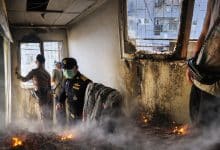Greenpeace outs Thailand’s worst smog areas

At least 10 suburbs in nine Thai provinces are being called out by pollution watchdog Greenpeace.
The organisation has revealed its rankings for 2018 based on a satellite map of PM2.5 concentrations in Thailand and the neighbouring countries of Myanmar, Laos and Cambodia.
Greenpeace is calling for the Thai government to improve the Ambient (Outdoor) Air Quality Standards for PM2.5 in order to protect people’s health.
The official “unsafe” level should be reduced from 50 to 35 |micrograms per cubic metre for the 24-hour mean concentration and to 12 from 25 micrograms per cubic metre for the annual mean.
In comparison, the World Health Organisation (WHO) has set the PM2.5 standard of limiting the 24-hour mean concentration to 25 micrograms per cubic metre for not more than three days in one year, in order to protect human health.
Thai communities where the 24-hour mean concentration of PM2.5 exceeded the standard for a period of 19 to 68 days in 2018 were: Mahachai subdistrict in Samut Sakhon province, Mae Pah subdistrict in Tak; Song Kanong subdistrict in Samut Prakan; Sripoom and Chang Phuak subdistricts in Chiang Mai; Mae Moh subdistrict in Lampang; Na Phra Land subdistrict in Saraburi; Nai Muang subdistrict in Khon Kaen; Itarapitak in Thon Buri and Din Daeng district in Bangkok.
“It is evident that people living in these urban areas are facing high risks of short and long-term impacts from continuous exposure to high levels of PM2.5,” Greenpeace concluded.
“The lack of progressive measures to manage this air pollution problem could potentially lead to an expanding public health crisis in the country.”
Greenpeace has urged the Thai Pollution Control Department and the Ministry of Natural Resources and Environment to urgently improve the Kingdom’s outdoor air standards “to ensure clear and practical achievement of Asean’s “Haze-free 2020” target to which Thailand is a signatory.
Meanwhile, the Pollution Control Committee has authorised the governors of Bangkok and nearby provinces to declare a “nuisance problem control area” under the Public Health Act and to take more drastic action if the levels of PM2.5 – airborne particulates 2.5 microns or less in diameter – exceeded 75-100 micrograms per cubic metre of air, Pollution Control Department director-general Pralong Damrongthai said.
SOURCE: The Nation
Air quality readings for Pattaya and Bangkok on Saturday morning…


Latest Thailand News
Follow The Thaiger on Google News:


























